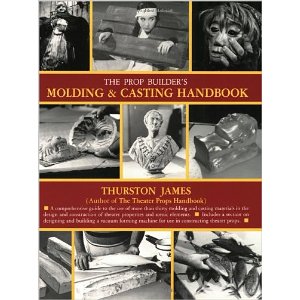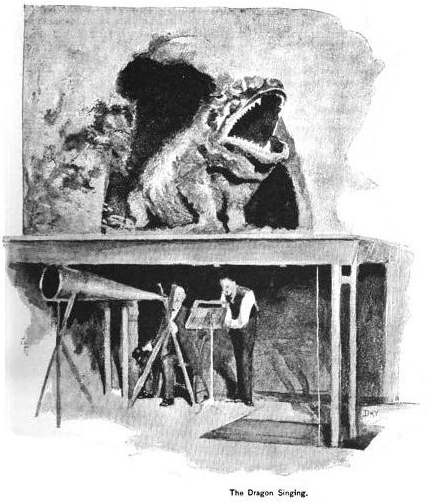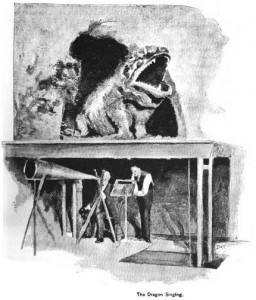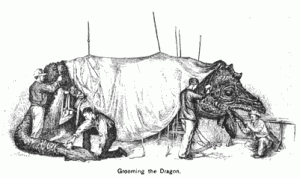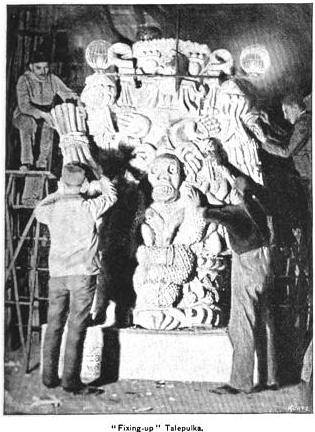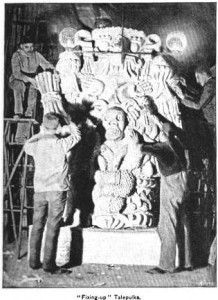The following originally appeared in a 1910 article by Algernon Tassin.
The rule of the drama, then, seems to be that though all may occasionally hunger, only the comedian may eat. But the gilded épergne heaped high with untempting fruit as the chief furniture of the festive board still remains to be accounted for. The official reason is simplicity itself. Nothing is so apparent as fruit, especially when in high-piled charactry. Since even if the pile were to be ravaged, none of it would there be eaten (and all providers have from time immemorial objected to fruit being taken from the table!), why not have a permanent pile? Thus the épergne and its fruit are one and indivisible, now and forever—they are papier maché. It is naught but the money-saving device of the manager and the labour-saving device of the property boy to escape the nightly marketing. When the Standard Edibles Syndicate is able to get Congress to pass a law prohibiting papier maché on stage-tables, one may be confident that the Associated Order of Stage Mechanics will be powerful enough to get it rescinded. For in the matter of food the second fundamental law of the drama is the Property Boy.
The disquieting trend toward realism begun by Herne and other obsessed disturbers of his peace, he has at least been able to check by ingenious shifts of well-nigh the longevity of papier maché. I recall a banquet table in a ducal hall whereon the perennial épergne which sufficed for our fathers was deemed by some objector in the audience inadequate to the growing demand for actuality. There must be some food capable of being toyed with if such silly people were to be silenced, and the manager thought a light salad of the escarolle pattern would be just the thing. This the property boy proceeded to mix as follows. Purchasing several yards of imperishable Bologna sausage, he minced a few slices at each performance and served them garnished with excelsior. These in individual plates with the communal and lordly épergne in the centre decked the table bountifully. The property boy surveyed the results of his ingenuity with satisfaction well merited; for the salad needed only dusting to be nightly serviceable, and when travelling the épergne and the sausage went together snugly packed in the excelsior. This banquet—although three of the characters on the stage upon being graciously summoned to supper by the duchess loudly proclaimed their hunger—sufficed unrenewed the season through. The star (not being a comedian) failed to be distressed by the languid appetite of her guests, but upon being reproached once more by some captious realist in the audience for the lack of verisimilitude, insisted that at least one of the actors eat of her generous fare. Whereupon the fertile property boy served the designated actor with three dried prunes, of which he afterward kept a bag in stock (which was simple enough, as it travelled also with the salad), all ready for just such centres of culture where exacting critics might reside. “You can cut these up,” he explained, “and they might be anything.” It was true, for the beneficent prune has boundless powers of assimilation: upon the arrogant table of Camille it may become the mushroom and the truffle, or at the board of Louise it may simulate the humble goulash. But the property boy is not constantly engrossed in calculating how he may save his labour and his food allowance; he has his careless and his genial hours. I once beheld upon the stage three intrepid and clinking dragoons toss off a forbidden bumper to an exiled king. When the foremost, with a magnificent flourish, dashed down upon the floor his drained glass and the others followed suit, it was a spirited moment. But when he precipitately dashed himself from the room the effect was somewhat marred. The others held their ground, indeed, but they visibly contended with surprising emotions which they sought to contain. Long afterward the secret of their eccentric behaviour was made plain; by accident or sportiveness the property boy had flavoured their cold-tea with varnish.
Thus either from the nature of Art or the nature of the Property Boy, the theatrical appetite is destined to be thwarted. The question then arises, Why in this regard should not dramatists write with an eye upon the stage? Why should we not have in the theatre jam yesterday and jam to-morrow, but never jam to-day? As the actor (unless intentionally comic) must ever like Jealousy mock the meat he feeds on, why give him food at all? “Each heart hath its sealed chamber,” says a heroine, and why not the stage? Let the dining-room door be barred, for when we enter it we leave illusion behind. If food must be, let it be laid out in the next room. Or if the table be needed for the setting of the stage, let the actors fall to only as the curtain falls; or—for the épergne is always there to lend atmosphere—let the meal be terminated by a messenger boy before ever the soup or even the useful celery. For this or any other coup de grace before meat all lovers of illusion will be truly thankful. Anything is better than the eternal listlessness of apparently healthy people in face of food.
“I do not believe,” says Joseph Jefferson —who was by no means a lover of realism —”that the introduction of cabbage and potatoes in the banquet scene of Macbeth would make the play one bit more interesting.” But the unfair illustration is not even pertinent. At the banquet in Macbeth no one is required to eat—it is interrupted before it really begins. The illusion is entirely preserved by the épergne as a coming event which throws its shadow before, and the guests depart ere its perfidy is disclosed. In his increasing dalliance with real life and common sense, let the modern playwright beware of banquets or even lunch baskets. They are but Barmecidal. Since no one may eat but the comedian—whose crammed cheeks do not provide an inextinguishable delight except in vaudeville—let him even reform food altogether, save that which can with reasonableness be nibbled. The food problem on the stage can only be settled by universal boycott.
Written by Algernon Tassin. First appeared in The Bookman, Volume 31, published by Dodd, Mead and Co., 1910.

